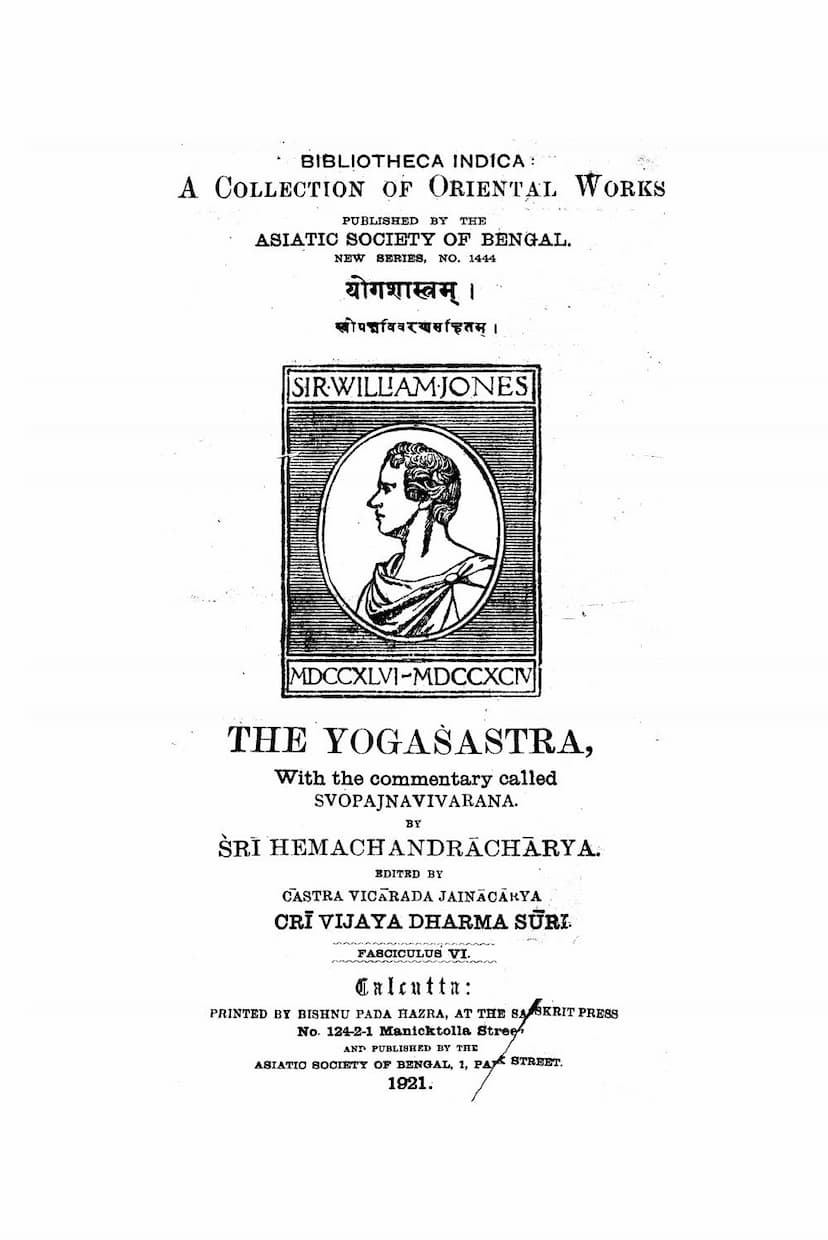Yogshastra Part 06
Added to library: September 2, 2025

Summary
This document is Fasciculus VI of The Yogaśāstra, a Jain text authored by Śrī Hemachandrāchārya and with a commentary called Svopajnavivaraṇa. It was edited by Castra Vicarada Jainācārya Śrī Vijaya Dharma Sūri and published by the Asiatic Society of Bengal in Calcutta in 1921 as part of the Bibliotheca Indica series.
The provided pages focus on the Fourth Prakash (Chapter) of the Yogaśāstra, which delves into the concepts of control of the senses (Indriya Jay) and the path to liberation (Moksha).
Here's a summary of the key themes and arguments presented in these pages:
The Primacy of Contentment (Santosh) and Renunciation:
- The text begins by extolling contentment (Santosh) as the highest virtue, even surpassing worldly power. It argues that true happiness and freedom come from detachment from desires.
- It suggests that contentment is the key to overcoming greed (Lobha) and that abandoning worldly possessions is a consequence of achieving contentment.
- The text critiques the pursuit of worldly pleasures and possessions, emphasizing that they are ultimately fleeting and do not bring lasting happiness.
The Importance of Sense Control (Indriya Jay):
- A significant portion of the text focuses on the crucial role of controlling the senses (Indriya Jay) in the spiritual journey.
- It argues that without conquering the senses, one cannot conquer inner defilements like anger, pride, deception, and greed (Kashaya).
- The senses are metaphorically described as wild horses that, if uncontrolled, lead to immense suffering and rebirth in hellish realms.
- Examples are given of how uncontrolled senses lead to downfall and destruction in both individual lives and entire lineages (e.g., Ravana, Sodas).
- The text emphasizes that true victory lies not in simply abstaining from sensory experiences, but in developing detachment and equanimity (Raga-Dvesha Vimukta) towards them.
The Role of the Mind (Manas):
- The mind is identified as the root cause of wandering and suffering. It's described as a restless monkey that needs to be controlled.
- Mental purity (Manah Shuddhi) is presented as the most potent means to achieve sense control. Other practices like yama, niyama, and service to elders are considered secondary or less effective without it.
- The text warns that an uncontrolled mind can lead to a fall into the cycle of birth and death (Samsara).
The Power of Mental Purity and Spiritual Practices:
- Mental purity (Manah Shuddhi) is portrayed as a guiding light leading to liberation. It's described as an unfading lamp that illuminates the path to Nirvana.
- Practices like meditation (Dhyana) and asceticism (Tapa) are deemed ineffective without mental purity.
- The text highlights the importance of understanding the impermanence of worldly things (Anityata), the lack of refuge in worldly possessions (Asharana), and the solitary nature of one's spiritual journey (Ekatva).
The Twelve Bhavanas (Meditations on Impermanence, etc.):
- The text then outlines several key spiritual contemplations or "Bhavanas" that are crucial for spiritual progress. These include:
- Anityata (Impermanence): Contemplating the transient nature of the body, wealth, youth, and life itself.
- Asharana (Lack of Refuge): Realizing that no worldly entity can provide true refuge from death and suffering.
- Samsara (Cycle of Birth and Death): Understanding the endless cycle of rebirth in various forms and the suffering associated with it.
- Ekatva (Solitariness): Recognizing that one is ultimately alone in experiencing the consequences of their actions.
- Anyatva (Difference): Differentiating the soul from the body, wealth, and relationships.
- Ashuchi (Impurity): Contemplating the impure nature of the physical body.
- Ashrava (Influx of Karma): Understanding how actions of mind, speech, and body lead to the influx of karma.
- Samvara (Cessation of Karma Influx): The practice of stopping the influx of new karma.
- Nirjara (Shedding of Karma): The process of burning away accumulated karma through asceticism and spiritual practices.
- Dharma (Righteousness): The understanding and practice of the true Jain principles, such as non-violence, truthfulness, non-stealing, celibacy, and non-possession.
- Loka (The Universe): Contemplating the structure and nature of the universe.
- Each Bhavana is described with its purpose and the consequences of neglecting it.
The Power of Equanimity (Samata) and Renunciation:
- Equanimity (Samata) is presented as a powerful tool to overcome passions like attachment (Raga) and aversion (Dvesha).
- It's described as a cleansing stream that washes away karmic impurities.
- The text further emphasizes the importance of detachment (Nirmamatva) and the relinquishing of possessions and ego.
In essence, this fasciculus of the Yogaśāstra provides a profound discourse on the Jain path to liberation, highlighting the necessity of rigorous self-discipline, control of the senses and mind, and deep spiritual contemplation to break free from the cycle of suffering and achieve ultimate spiritual purity and freedom.